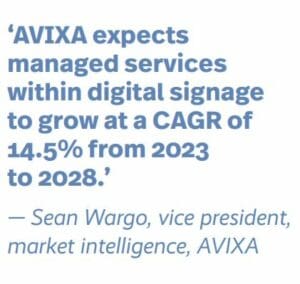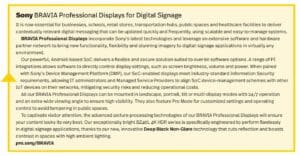Our industry has bandied the term “digital signage” about for a couple decades now, but this technology seems to be a hotter topic today than ever before. With the COVID-19 pandemic in the rearview mirror, AV professionals are back to leaning into immersive, experiential technology integration. Naturally, large-format digital signage has a huge role to play in that. Moreover, with our society continuing to suffer from an epidemic of mass shootings and other dangerous situations, it is imperative for corporate, education and government campuses to deliver critical messaging quickly. Increasingly, decision-makers recognize that digital-signage networks are the optimal means to convey urgent information. And that’s not even to mention the ubiquity of digital signage in transportation hubs like airports, where timely, accurate information is a traveler’s most valuable currency.
In this, Commercial Integrator’s annual Digital Signage Deep Dive report, we will examine all facets of the digital-signage market. These include how it fits into integration businesses’ overall portfolio, key revenue and margin trends, inhibiting factors, vertical-market bright spots and weak spots, leading technologies, and the importance of managed services and content creation.
Digital Signage: Is Demand Reaching New Heights?
Kristin Bidwell, director, managing consultant, ACT Associates, testifies to a steady increase in digital-signage applications throughout the commercial AV industry. “I haven’t had a project this year that has not incorporated some sort of digital signage,” she continues, pointing to everything from displays in reception areas and lobbies, to sales-driving retail digital signage, to large-scale, eye-catching videowall applications.
Bidwell believes that the pandemic accelerated the growth of the digital-signage market, arguing that it changed human behavior. “[People] are now accustomed to contactless transactions and are seeking greater digital experiences,” she opines, adding that, as a result, businesses have had to find new ways to communicate with customers.
Related: Digital Signage: A Complete Guide
Joseph Mendonca, director, business development, AVI-SPL, amplifies this view, estimating that approximately 60% of AVI-SPL projects involve digital signage of some kind. He says that, today, the quality of the experience is equally as important as the functionality integrators implement in physical and digital spaces. “We are experiencing extensive digital transformation taking place in the workplace, healthcare, education, retail, transportation, manufacturing, entertainment and corporate,” Mendonca explains. “Digital signage is playing an essential role in making these changes successful.”
Likewise, Joe Mahurin, vice president of sales – workplace/digital experience, Diversified, attests that a large percentage of the integrator’s overall projects include digital signage and related offerings. “Organizations of all kinds are seeking to create unparalleled and unforgettable experiences that grow connection with their customers, fans and employees,” he declares. “Digital signage is a big part of that.”
Although Sean Wargo, vice president, market intelligence, AVIXA, is anything but a digital-signage skeptic, he tamps down some of the ebullience by pointing to data from AVIXA’s Industry Outlook and Trends Analysis (IOTA) report. “Current-year estimates are for signage revenue for pro AV to increase by 6.4%,” he explains, “versus 9.4% last year.” Wargo continues, “With other categories growing faster, this means signage spending is a lower percent of total AV spending in 2023, which may, in turn, translate down to the integrator level.” And, indeed, Bryan Meszaros, CEO and founder, OpenEye Global, describes 2023 as “a reasonably flat year.” He continues, “We saw a cautious approach from our clients. Most of the projects we saw come in were related to existing initiatives, either additional creative or some minor upgrades in legacy equipment.”
Revenue and Margins
Although every integrator aims to achieve functional and experiential excellence, each one is, of course, also a business. That means, when integrators evaluate the digital-signage opportunity, they must think about revenue potential and margins.
Jason Ault, co-founder and COO, Coffman Media, whose firm specializes in digital signage, attests to revenue increases in the digital-signage space over the past 12 months, while acknowledging that hardware margins remain quite thin. “However,” he hastens to add, “services and software still have tremendous margins — recurring, in some cases — if the right vendor partnerships are formed.” Mendonca expresses a similar view, saying that the business model for digital-signage providers has changed from selling equipment to providing a complete set of managed services to achieve successful business outcomes. “Managing the overall digital-signage strategy — the technology, the content, the users and the outcomes — [is key] to any successful digital signage initiative,” he states. Meszaros drives home the point further, declaring, “There is significant revenue in the digital-signage space, but it comes on the professional-services side, especially skewed toward content management and design.”
But Bidwell urges channel members not to dismiss the margin opportunity in digital signage altogether. “Over the past 12 months, I have seen an increased number of digital-signage manufacturers aggressively trying to get their foot in the door at integration firms,” she attests. “The margins have continually increased in the integrator’s favor.” In fact, Bidwell says, she has seen these margins vary from 15% up to a whopping 50% as vendors attempt to capture a piece of the market. Apart from pricing incentives, she continues, “…some manufacturers offer extended warranties, better technology, local shipping and services, and easier mounting solutions.” The bottom line? Bidwell compellingly argues that integration firms can generate a lot of revenue through digital-signage applications.
Considering Inhibiting Factors
The market opportunity that digital signage presents is beyond dispute, but that doesn’t mean there are no inhibiting factors for channel members to consider. Ault counterposes the traditional integration model — basically, install the solution and then onto the next project — to the investment that digital signage requires. “You need a support team to take in support tickets with swift [service-level agreements (SLAs)]; a customer-retention team to ensure the licenses under management have a low churn rate to build the profitability engine of the new solution arm of the company; and additional sales, operations and support teams to go after the new opportunities,” he explains, “and then be able to deploy them into the field.” 
Staffing up those various teams is, of course, a challenge in a constrained labor market. As Mendonca attests, “At AVI-SPL, the talent shortages have been most impactful to our growth, and [that] will continue to be the case for the foreseeable future, whereas other macro-level factors like tight budgets and lead times are manageable and less impactful.” Looking from an industrywide perspective, Wargo agrees, saying, “While supply is likely to continue improving, hiring is likely to remain a long-term issue.”
General economic uncertainty also weighs on the digital-signage market; indeed, forecasters have been evaluating recession risks for months, vacillating between optimism and pessimism. What I might call “CNBC anxiety” naturally plays a part in decision-makers’ thinking as regards purchasing and installing AV systems. According to Bidwell, “In recent months, I have seen some hesitation to purchase large-ticket items in fear of a recession and due to stock prices dropping.” Mendonca emphasizes that point, saying, these days, “…every dollar gets scrutinized by the business to ensure that the investment makes business sense and will return the highest business value.” Given economic worries, he says, it’s more important than ever for digital-signage providers to play an active role as educators and advisors. According to Mendonca, it comes down to “…helping customers develop the right business cases that justify the business value for deploying digital signage to their organization.”
Digital Signage: The Next 12 Months
Although Wargo was a voice of caution earlier in this piece as regards signage revenues this year, he states that AVIXA’s IOTA report paints a rosier picture as we look at the next 12 months and beyond. The report “…shows better growth for signage over the next couple of years, as recession risks abate and core markets continue to grow,” Wargo explains. “[IOTA] shows 7.1% growth in signage revenue in 2024, followed by 7.4% in 2025.” Bidwell’s independent study of market reports aligns nicely with AVIXA’s conclusions. “I expect to see a 6% to 8% growth rate in digital-signage-centered revenue over the next 12 months,” she says. “I am optimistic [about] digital signage being a larger piece of most commercial integrators’ pie in 2024.”
If you ask Meszaros, there is good reason for optimism about 2024. Harking back to his comments about 2023 being somewhat flat, he says, “Most of the new opportunities we saw eventually reallocated to 2024. From the activity in Q4, we see digital signage returning to a prominent role next year.” Other companies such as Coffman Media — the integrator that is exclusively focused on digital signage — are looking at numbers many integrators have not yet attained.
According to Ault, “We are forecasting revenues to be 35% to 38% over 2023 based on our current trend YTD in 2023 sitting at 32% from 2022.” He underscores that digital signage is not only a fast-growth category but also a category that’s broadly compelling across markets. “All verticals need to have a platform for communication to reach their intended audience,” he declares.
And that last point is exactly why two of our industry’s leading integrators — AVI-SPL and Diversified — are so bullish about digital signage in 2024. Mendonca describes “a complete paradigm shift” from the old days of implementing digital-signage solutions as standalone projects. “Now, [it’s] an integral part of a company’s DNA for how it communicates, collaborates, connects, engages, educates, promotes and entertains their target audiences across the entire organization,” he says.
Mahurin says that Diversified has developed a strategy to grow digital signage and digital experiences for that very reason. “The need to distribute content or digital messaging will continue to be a critical part of any company’s communication strategy,” he opines, “along with utilizing that data to drive better decision-making.” Unsurprisingly, then, both firms expect to realize significant digital-signage growth over the next 12 months.
High-Growth Vertical Markets for Digital Signage
It’s true that digital signage is a compelling opportunity across verticals, but not all markets are equally ripe. All of our experts agree that retail has been a growth area, and the opportunity remains robust. “This year,” Meszaros reports, “we have seen an upward trend in retail programs, mainly driven by CPGs exploring innovative ways to increase engagement at the shelf.” Bidwell agrees with him, calling retail the most prominent segment and saying data from Grand View Research and Market.US indicates that retail commanded about one-fifth of digital-signage market share in 2022. “Digital posters have become increasingly popular in retail,” she explains. “They provide a cost-effective solution in producing advertisements and attracting target customers.”

Retail and transportation remain the strongest markets for digital signage, but hospitality is also in the mix as a great vertical for eye-catching display technology. Image supplied by OpenEye Global; photo credit Kyle Zirkus Photo.
Bidwell notes that the transportation segment is likely to emerge as one of the fastest-growing market segments over the next six years, with a compound annual growth rate (CAGR) of 9.8% or more expected. “Digitized posters and advertisements in airports, bus stands, subway stations and on roads used by taxi cabs and public buses [reach] a lot of people in a small amount of real estate,” she says. Wargo agrees that retail and transportation remain the strongest markets for digital signage, but he adds hospitality to the mix. “With retail results doing well in the U.S. and consumers traveling even more than they did in 2019, thereby bolstering the hospitality and transportation markets, signage has a good context for growth,” he observes. Wargo hastens to add that integrators shouldn’t overlook venues and events, as well, as this market is experiencing high growth and naturally lends itself to experiential, immersive signage.
Mendonca, meanwhile, turns the conversation to the corporate space, in which AVI-SPL is enjoying growth. As he explains it, “The requirements for better and more meaningful in-office experiences; challenges communicating to a distributed workforce; keeping that workforce engaged and connected to the company’s vision and mission in a hybrid-working model; the need for data visualization; and the need to keep everyone better informed, productive and safer — [these] are all driving factors for the expected growth in the corporate space.” Ault also points to high growth in corporate communications, including manufacturing and plant floors, while Mahurin says that the financial sector is evincing expansion and strength.
Digital Signage: Vulnerabilities in Vertical Markets
Now that we have a sense of which verticals are robust, let’s explore some possible vertical-market vulnerabilities for digital signage. Mahurin doesn’t at all dispute the value of digital signage on corporate campuses, but he says, “We see vulnerability in corporate environments that still have most of their employee base working from [a] home office or remote.” Bidwell agrees with this point, saying, “Businesses may rethink their spending in offices where in-office collaboration has been replaced by virtual workplaces.”
Related: Best Corporate Campus Project: CCS’ New National Headquarters Wows
Although we discussed earlier that retail has been, and remains, a stalwart for digital signage, Meszaros counterbalances exuberance with notes of caution, underlining the vertical’s trademark volatility. He reemphasizes opportunities emerging from the CPGs but says, “We haven’t seen any exciting opportunities from our ‘brick-and-mortar’ clients. I expect much of that is due to consumer in-store shopping frequency and dollars being reallocated toward mobile and e-commerce systems.” Bidwell agrees, pointing to the Amazonification of the shopping landscape. “The need for digital signage at retail locations could diminish over time as more consumers shop from home,” she reasons, “and [as] advertising budgets are split between in-person and online stores.” For his part, Mendonca groups small and mid-size retailers together with QSR operations, saying all of them are vulnerable to economic downturns and, thus, being more reserved as regards digital-signage investments.
Meanwhile, Ault pivots from vertical markets entirely, instead choosing to focus on vulnerability that emerges from integrators and solutions providers failing to consult with a potential client and “go on a discovery journey with them” to understand why they need digital signage. The real work, he says, lies in “truly [defining the client’s] objectives, content path, first 36-month roadmap, SLAs and refresh cycles.” Only when the integrator has laid that groundwork, Ault adds, can they formulate a hardware, software and services solution. Mike White, principal at AV-Maven, drives home this message. “One can only sell and successfully implement digital signage by asking questions — specific questions — that yield the path to success to meet return on investment, return on objective and return on attention of the customer,” he espouses.

Many factors are driving digital signage’s strength in the corporate sector: the requirement for better and more meaningful in-office experiences, the desire to keep the workforce engaged and connected to the company’s vision and mission, and the need to keep everyone better informed, more productive and safer. Image supplied by OpenEye Global; photo © AJ Brown Imaging.
Considering Display Choices for Digital Signage
Over the last few years, the commercial AV industry’s enthusiasm for direct-view LED (DVLED) technology has only grown. It’s only natural, then, that our experts zero in on DVLED as the top choice for most digital-signage deployments. Mendonca readily concedes that projection, OLED and QLED are readily usable in specific use cases, but he adds, “The technological improvements in DVLED and microLED — from pixel density to the quality, serviceability and manageability of these displays — are making DVLED a more desirable option.” That said, Mendonca observes that, for standard digital signs that are 100 inches or less diagonal, LCD technology will continue to be the mainstream option. Wargo backs this up, saying, “LCD still rules for smaller-format installations as a volume product.”
 Ault agrees with Mendonca about DVLED’s increasingly compelling value proposition, pointing out that architects are familiarizing themselves with digital signage generally — but specifically with DVLED, whose costs continue to come down. Meszaros picks up on architects’ involvement, saying that their aesthetics-minded approach has become determinative in many projects. “We collaborate pretty often with architects and theming agencies looking at digital signage with a ‘design-style’ POV,” he attests. “So, we are constantly working to maintain their expectations but still satisfy the objectives of the space.” More often than not, that means deploying DVLED, a technology that, as Bidwell puts it, “…provides a larger, brighter, thinner and higher-quality image when compared to LCDs.”
Ault agrees with Mendonca about DVLED’s increasingly compelling value proposition, pointing out that architects are familiarizing themselves with digital signage generally — but specifically with DVLED, whose costs continue to come down. Meszaros picks up on architects’ involvement, saying that their aesthetics-minded approach has become determinative in many projects. “We collaborate pretty often with architects and theming agencies looking at digital signage with a ‘design-style’ POV,” he attests. “So, we are constantly working to maintain their expectations but still satisfy the objectives of the space.” More often than not, that means deploying DVLED, a technology that, as Bidwell puts it, “…provides a larger, brighter, thinner and higher-quality image when compared to LCDs.”
Zooming in even further, Bidwell highlights transparent LED displays as a noteworthy growth category, citing market research from Grand View Research and Market.US. Her sources indicate a forecasted CAGR of more than 10.5% through 2030. “Transparent LED displays offer high resolution with remarkable transparency, and [they] are energy efficient,” she explains. Bidwell points to global trends pushing businesses to embrace energy-efficient audiovisual solutions that both reduce overhead costs and assist in meeting sustainability goals. “These factors will help support the growth of transparent LEDs,” she predicts. On the topic of power consumption, Meszaros adds that, as of late, OpenEye Global is receiving requests for unique ways to power digital-signage devices. “[Clients are requesting] PoE-enabled displays, wireless charging for ‘all-in-one’ units that sit on a retail shelf, as well as low-powered displays like E-ink,” he specifies.
Managed Services for Digital Signage
Earlier in this article, our experts advanced a case that integrators most richly benefit from digital-signage work when they embrace a software-forward, services-first, consultative approach. That naturally leads many integrators to wonder how best to approach digital-signage managed services — or to question whether they really have to do things that way. “It is not likely the case that most integrators are offering managed services,” Wargo acknowledges. “Some percentage [of them] are, but it is likely closer to 25% to 30%.” However, he hastens to add, revenues from managed services are growing at an impressive rate. (This is perhaps an indicator that more integration businesses are coming to realize the potential to earn recurring revenue, cement client relationships and deliver better outcomes.) Indeed, according to Wargo, “AVIXA expects managed services within digital signage to grow at a [CAGR] of 14.5% from 2023 to 2028.”
 Meszaros casts the question of digital-signage managed services in existential terms, saying, “I don’t see how a business survives in this industry if you do not offer, or at the very least partner with a group to provide, an element of ongoing support.” He continues, “Most clients — if not all clients — we encounter are not set up [to], nor [do they] want to, manage their own program.” But Meszaros is clear-eyed that it’s not easy to execute or structure digital-signage service offerings. “You offer a specialized service, often tailored to the client’s needs,” he explains. “And the deployment of those needs will vary, which makes it challenging for an organization to support.” But the bottom line is that integrators who scale that mountain have a leg up on their peers. “Those that have a managed service offering in place have an advantage over their competition,” Bidwell states definitively.
Meszaros casts the question of digital-signage managed services in existential terms, saying, “I don’t see how a business survives in this industry if you do not offer, or at the very least partner with a group to provide, an element of ongoing support.” He continues, “Most clients — if not all clients — we encounter are not set up [to], nor [do they] want to, manage their own program.” But Meszaros is clear-eyed that it’s not easy to execute or structure digital-signage service offerings. “You offer a specialized service, often tailored to the client’s needs,” he explains. “And the deployment of those needs will vary, which makes it challenging for an organization to support.” But the bottom line is that integrators who scale that mountain have a leg up on their peers. “Those that have a managed service offering in place have an advantage over their competition,” Bidwell states definitively.
Unsurprisingly, then, top-tier integrators like Diversified, AVI-SPL and Coffman Media have established strong digital-signage service offerings. Diversified, for example, offers Digital Signage as a Service, as well as a full, turnkey solution suite in its managed-service offering. Mahurin reports that the solution suite encompasses design/consulting, content and creative services, distribution and deployment models, remote monitoring and management, data analytics and lifecycle management. According to Mendonca, AVI-SPL’s full set of digital-signage managed services is equally robust. The offering includes proactive technology monitoring, execution of self-healing tasks, complete incident management to full resolution, onsite technical resources and break-fix SLAs, and a variety of content services. Meanwhile, Coffman Media’s service offering entails having an active pulse on the negative or positive operating KPIs, with full ability for Ault and his team to fix issues proactively. “Thus,” he says, “[we] optimize uptime and solution success, leading to maximum value and happy clients.”
Considering Content for Digital Signage
There seems to be little dispute about managed services’ utility in delivering excellent digital-signage outcomes. But it’s still a debatable question whether AV integrators should dive headlong into the content-creation game. For Mendonca, the answer is clear: Either develop a content core competency yourself or find a partner who can shore you up. As he puts it, “Creating the day-one content, creating branded templates for users to compose their messages, creating ongoing content assets, creating a content strategy that aligns with the customer’s business objectives — [these] are all part of the responsibilities of a digital-signage provider.” Mahurin amplifies this point, saying that digital signage simply doesn’t work without a rock-solid content and creative strategy. “Having the ability to guide your customers through this journey is imperative,” he declares. “It would be difficult to label yourself a digital-signage provider without this component.”
 Other experts passionately argue that clients are best served when integrators partner with dedicated creative agencies for content. “From experience, an integrator lacks the culture and business acumen needed to sustain a creative agency,” Meszaros opines. “Turning out content like a machine to generate revenue harms an industry starting to see significant growth.” He underscores that firms like his value their close relationships with integrators, and he advances the view that each party needs to lean on the other’s expertise. “From an integrator perspective, it’s OK to have familiarity with the creative process,” Meszaros says. “Still, it often falls flat when they establish it as a service using an IT-driven mentality.”
Other experts passionately argue that clients are best served when integrators partner with dedicated creative agencies for content. “From experience, an integrator lacks the culture and business acumen needed to sustain a creative agency,” Meszaros opines. “Turning out content like a machine to generate revenue harms an industry starting to see significant growth.” He underscores that firms like his value their close relationships with integrators, and he advances the view that each party needs to lean on the other’s expertise. “From an integrator perspective, it’s OK to have familiarity with the creative process,” Meszaros says. “Still, it often falls flat when they establish it as a service using an IT-driven mentality.”
Bidwell falls into the camp of integration firms partnering with content-creation professionals — and doing so early in the project. “The earlier content is introduced into the conversation, the better,” she avers. “Making sure the content makes sense for the environment and the displays make sense for the content that is being created plays a large role in providing the best user experience.” Wargo underlines the binary choice — integrators must further broaden their competency set or partner accordingly — but he points to emerging technology as a possible way to ease integrators’ path. “Generative AI enables [content creation] to some extent since it provides integrators with a toolset for delivering a content stream in a cost-efficient fashion,” Wargo observes.

Many factors are driving digital signage’s strength in the corporate sector: the requirement for better and more meaningful in-office experiences, the desire to keep the workforce engaged and connected to the company’s vision and mission, and the need to keep everyone better informed, more productive and safer. Images supplied by OpenEye Global; photos ©AJ Brown Imaging.
The Many Facets of Digital Signage
As we have seen, integration businesses have much to consider when it comes to digital signage. The ripe opportunity is very much present, but enduring success requires a consultative approach with clients, strategic vertical-market choices, an embrace of hot technologies like DVLED, a willingness to sell services and assured outcomes, and close connections to content creators. All that might sound like a lot, but it’s a small price to pay to optimize your business and get your share of the countless millions available to be earned.
We’ll give Mike White, a longtime, passionate digital-signage evangelist, the last word. He says, “This CI Deep Dive confirms that digital signage is growing rapidly and will continue to grow virally for many years to come. The big question — or challenge — is [whether] integrators will lift their head from the hectic work pace in traditional AV to embrace digital signage and the role it can play in their future to maintain margins and increase business valuation.” Although no one can predict the future, we hope this report has given you some ideas — and perhaps some inspiration.
Hungry for more information about digital signage? Check out our Complete Guide!












